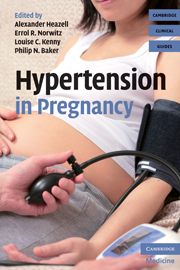29 results
Chapter 5 - Interventions in Pregnancy to Reduce Risk of Stillbirth
- from Section 1: - General Principles
-
-
- Book:
- Fetal Therapy
- Published online:
- 21 October 2019
- Print publication:
- 02 January 2020, pp 48-60
-
- Chapter
- Export citation
Fetal ultrasonography
- from Part II - Methods in child development research
-
-
- Book:
- The Cambridge Encyclopedia of Child Development
- Published online:
- 26 October 2017
- Print publication:
- 19 October 2017, pp 107-112
-
- Chapter
- Export citation
4 - Severe preeclampsiaand eclampsia
- from Section 2 - Algorithms for Management of the Top Five ‘Direct Killers’
-
-
- Book:
- Obstetric and Intrapartum Emergencies
- Published online:
- 05 November 2012
- Print publication:
- 11 October 2012, pp 24-32
-
- Chapter
- Export citation
Contributors
-
-
- Book:
- Obstetric and Intrapartum Emergencies
- Published online:
- 05 November 2012
- Print publication:
- 11 October 2012, pp ix-xii
-
- Chapter
- Export citation
Index
-
- Book:
- Hypertension in Pregnancy
- Published online:
- 05 August 2011
- Print publication:
- 26 August 2010, pp 185-190
-
- Chapter
- Export citation
6 - Management of isolated hypertension in pregnancy
-
-
- Book:
- Hypertension in Pregnancy
- Published online:
- 05 August 2011
- Print publication:
- 26 August 2010, pp 79-96
-
- Chapter
- Export citation
Preface
-
-
- Book:
- Hypertension in Pregnancy
- Published online:
- 05 August 2011
- Print publication:
- 26 August 2010, pp xiii-xiv
-
- Chapter
- Export citation
Copyright page
-
- Book:
- Hypertension in Pregnancy
- Published online:
- 05 August 2011
- Print publication:
- 26 August 2010, pp iv-iv
-
- Chapter
- Export citation

Hypertension in Pregnancy
-
- Published online:
- 05 August 2011
- Print publication:
- 26 August 2010
11 - Anesthesia in preeclampsia
-
-
- Book:
- Hypertension in Pregnancy
- Published online:
- 05 August 2011
- Print publication:
- 26 August 2010, pp 159-174
-
- Chapter
- Export citation
Contents
-
- Book:
- Hypertension in Pregnancy
- Published online:
- 05 August 2011
- Print publication:
- 26 August 2010, pp v-vi
-
- Chapter
- Export citation
Contributors
-
-
- Book:
- Hypertension in Pregnancy
- Published online:
- 05 August 2011
- Print publication:
- 26 August 2010, pp vii-x
-
- Chapter
- Export citation
Hypertension in Pregnancy - Title page
-
-
- Book:
- Hypertension in Pregnancy
- Published online:
- 05 August 2011
- Print publication:
- 26 August 2010, pp iii-iii
-
- Chapter
- Export citation
2 - The pathophysiology of hypertension in pregnancy
-
-
- Book:
- Hypertension in Pregnancy
- Published online:
- 05 August 2011
- Print publication:
- 26 August 2010, pp 19-34
-
- Chapter
- Export citation
Abbreviations
-
- Book:
- Hypertension in Pregnancy
- Published online:
- 05 August 2011
- Print publication:
- 26 August 2010, pp xv-xviii
-
- Chapter
- Export citation
Hypertension in Pregnancy - Half title page
-
- Book:
- Hypertension in Pregnancy
- Published online:
- 05 August 2011
- Print publication:
- 26 August 2010, pp i-ii
-
- Chapter
- Export citation
List of contributors
-
- Book:
- Obstetrics for Anaesthetists
- Published online:
- 21 August 2009
- Print publication:
- 06 March 2008, pp ix-x
-
- Chapter
- Export citation
Contents
-
- Book:
- Obstetrics for Anaesthetists
- Published online:
- 21 August 2009
- Print publication:
- 06 March 2008, pp vii-viii
-
- Chapter
- Export citation
9 - Obstetric haemorrhage
-
-
- Book:
- Obstetrics for Anaesthetists
- Published online:
- 21 August 2009
- Print publication:
- 06 March 2008, pp 107-119
-
- Chapter
- Export citation
Appendix 2 - The Management of Postpartum Haemorrhage Algorithm
-
- Book:
- Obstetrics for Anaesthetists
- Published online:
- 21 August 2009
- Print publication:
- 06 March 2008, pp 154-154
-
- Chapter
- Export citation

